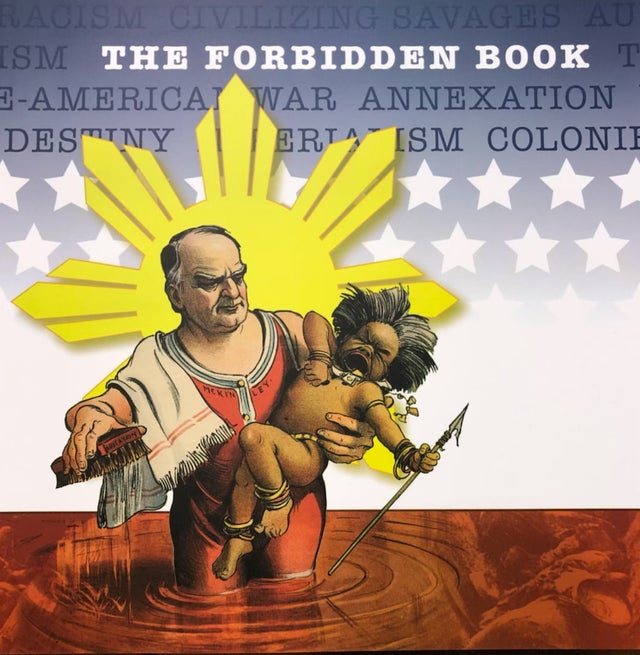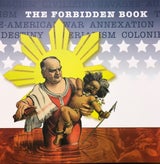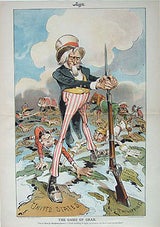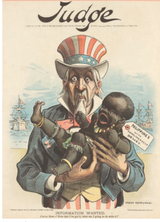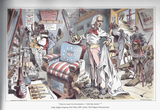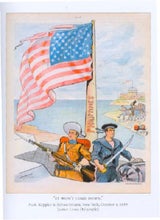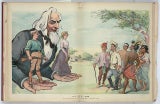- Asian American Studies
- >
- Filipino American Studies
- >
- The Forbidden Book: The Philippine-American War in Political Cartoons (Paperback)
The Forbidden Book: The Philippine-American War in Political Cartoons (Paperback)
SKU:
9781887764636
$35.00
$24.00
$24.00
On Sale
Unavailable
per item
Author: Abe Ignacio, Enrique de la Cruz, Jorge Emmanuel, Helen Toribio
Publisher: T'Boli / Eastwind Books of Berkeley: 2004
Format: Paper
Condition: New
ISBN: 9781887764636
Description
The Forbidden Book uses over 200 political cartoons from 1898 to 1906 to chronicle a little known war between the United States and the Philippines. The war saw the deployment of 126,000 U.S. troops, lasted more than 15 years and killed hundreds of thousands of Filipinos beginning in February 1899.
The book’s title comes from a 1900 Chicago Chronicle cartoon of the same name showing then-President William McKinley putting a lock on a book titled “True History of the War in the Philippines.” Today, very few Americans know about the brutal suppression of Philippine independence or the anti-war movement led at that time by the likes of writer Mark Twain, peace activist Jane Addams, journalist Joseph Pulitzer, steel magnate Andrew Carnegie, labor leader Samuel Gompers, and Moorfield Storey, first president of the NAACP.
The book reveals how the public was misled in the days leading to the war, shows illustrations of U.S. soldiers using the infamous “water cure” torture (today referred to as “waterboarding”), and describes a highly publicized court martial of soldiers who had killed prisoners of war. The election of 1900 pitted a pro-war Republican president against an anti-war Democratic candidate. In 1902, the Republican president declared a premature “mission accomplished” as the war was beginning to expand to the southern Philippines.
The book shows political cartoons glorifying manifest destiny, demonizing the leader of the Filipino resistance President Emilio Aguinaldo, and portraying Filipinos, Puerto Ricans, Cubans, Hawaiians, Chamorros, and other colonials as dark-skinned savages in need of civilization. These images were used to justify a war at a time when three African Americans on average were lynched every week across the south and when the Supreme Court approved the “separate but equal” doctrine.
More than a century later, the U.S.-Philippine War remains hidden from the vast majority of Americans. The late historian Howard Zinn noted, “The Forbidden Book brings that shameful episode in our history out in the open… The book deserves wide circulation.”
Winner of the Gustavus Myers Book Award (2005) and the Calatagan Award (2005)
Authors
Abe Ignacio is in charge of the Philippines collection at the San Francisco Public Library; Enrique de la Cruz is an Asian American Studies professor emeritus of Cal State Northridge University, Jorge Emmanuel is a historian and scientist; the late Helen Toribio is a historian, community activists and lecturer at San Francisco City College.
Reviews about the book.
Asian Journal Review. April 2014.
Also available in hardcover.
The Forbidden Book uses over 200 political cartoons from 1898 to 1906 to chronicle a little known war between the United States and the Philippines. The war saw the deployment of 126,000 U.S. troops, lasted more than 15 years and killed hundreds of thousands of Filipinos beginning in February 1899.
The book’s title comes from a 1900 Chicago Chronicle cartoon of the same name showing then-President William McKinley putting a lock on a book titled “True History of the War in the Philippines.” Today, very few Americans know about the brutal suppression of Philippine independence or the anti-war movement led at that time by the likes of writer Mark Twain, peace activist Jane Addams, journalist Joseph Pulitzer, steel magnate Andrew Carnegie, labor leader Samuel Gompers, and Moorfield Storey, first president of the NAACP.
The book reveals how the public was misled in the days leading to the war, shows illustrations of U.S. soldiers using the infamous “water cure” torture (today referred to as “waterboarding”), and describes a highly publicized court martial of soldiers who had killed prisoners of war. The election of 1900 pitted a pro-war Republican president against an anti-war Democratic candidate. In 1902, the Republican president declared a premature “mission accomplished” as the war was beginning to expand to the southern Philippines.
The book shows political cartoons glorifying manifest destiny, demonizing the leader of the Filipino resistance President Emilio Aguinaldo, and portraying Filipinos, Puerto Ricans, Cubans, Hawaiians, Chamorros, and other colonials as dark-skinned savages in need of civilization. These images were used to justify a war at a time when three African Americans on average were lynched every week across the south and when the Supreme Court approved the “separate but equal” doctrine.
More than a century later, the U.S.-Philippine War remains hidden from the vast majority of Americans. The late historian Howard Zinn noted, “The Forbidden Book brings that shameful episode in our history out in the open… The book deserves wide circulation.”
Winner of the Gustavus Myers Book Award (2005) and the Calatagan Award (2005)
Authors
Abe Ignacio is in charge of the Philippines collection at the San Francisco Public Library; Enrique de la Cruz is an Asian American Studies professor emeritus of Cal State Northridge University, Jorge Emmanuel is a historian and scientist; the late Helen Toribio is a historian, community activists and lecturer at San Francisco City College.
Reviews about the book.
Asian Journal Review. April 2014.
Also available in hardcover.

